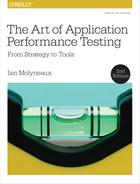Chapter 10. Conclusion
This is the end, my only friend, the end.
The Doors
Something I omitted from the first edition of this book was a concluding chapter. No one commented on its absence, but I thought in the revised edition it would be good to bring things to a close with a short look at future trends for performance testing. Certainly, understanding the end-user experience continues to be an ever-increasing focus of performance testing. The customer is king, and increasing conversions is the goal (at least for ecommerce).
More and more, the EUE is impacted by the plethora of mobile devices available to the consumer. Ironically, this makes IT’s job increasingly difficult as they try to ensure a good EUE across an ever-expanding range of devices, operating systems, and browsers. I predict that the inclusion of on-device automation will become the norm for performance testing, together with the deployment of application performance monitoring software into testing environments (with some overlap into development). The greatly increased insight into and triage capability of software performance that APM provides, along with the relative ease of integration with performance test tooling, makes APM in some form a must-have for most companies.
With the move to continuous integration (CI) driving ever-increasing numbers of releases in shorter and shorter time scales, gaining early insight into performance problems is critical. Performance test tooling, in conjunction with APM, is well placed to provide this visibility so that problems can be dealt with early in the application life cycle, thereby improving the quality, and importantly, speeding up the delivery of software releases.
What will happen to performance tooling vendors is less certain. Enterprises are now far more reluctant to invest in expensive tooling when they can get much the same capability from SaaS and open source alternatives. This is a challenge facing software companies in general; however, for performance tooling shops there has been an acute shift away from the established vendors for web testing requirements. Unless your performance testing need relates to some of the big customer relationship managers, enterprise resource planning packages (like BMC Remedy, SAP, or Oracle eBusiness Suite), or perhaps thin-client technology (like Citrix), then you really are spoiled for choice.
As a final thought, for those interested I extend an invitation to join my Performance Testers group on the popular business networking site LinkedIn. This group has been running for a number of years and has steadily grown to several thousand members. If you have a question on any aspect of performance testing, then I am sure that you will receive a helpful response. (You may even find gainful employment!) Best wishes and happy performance testing.
